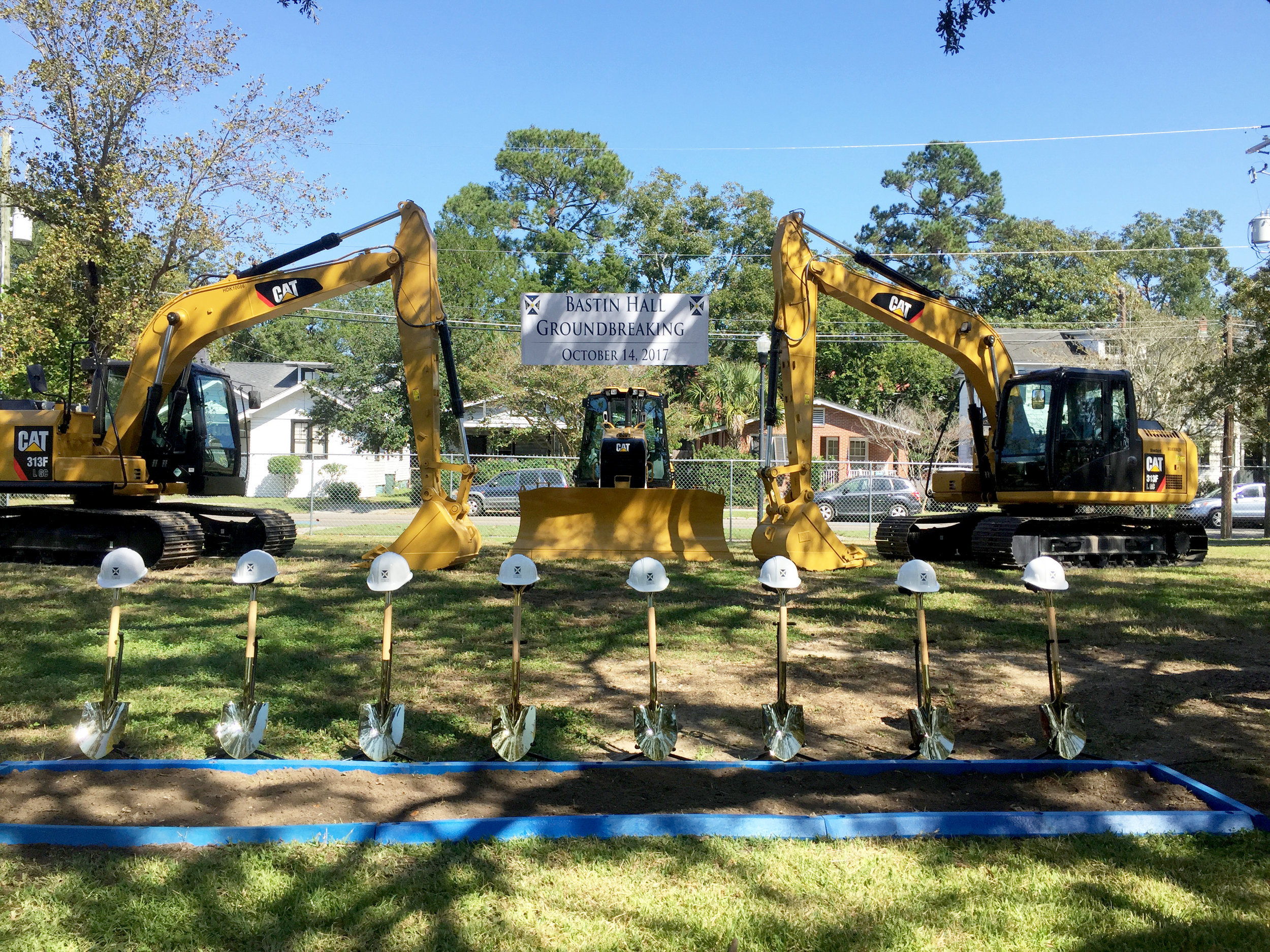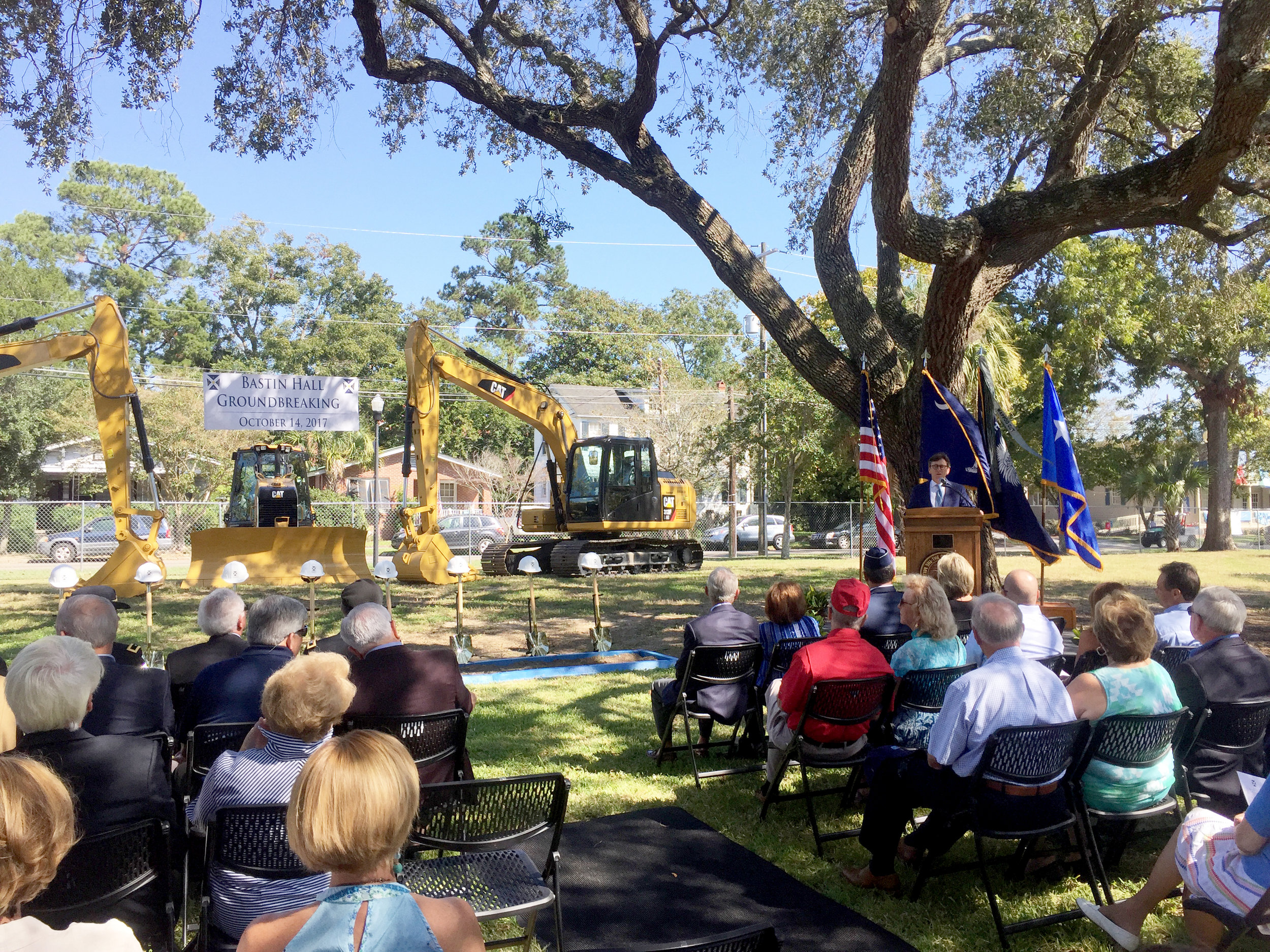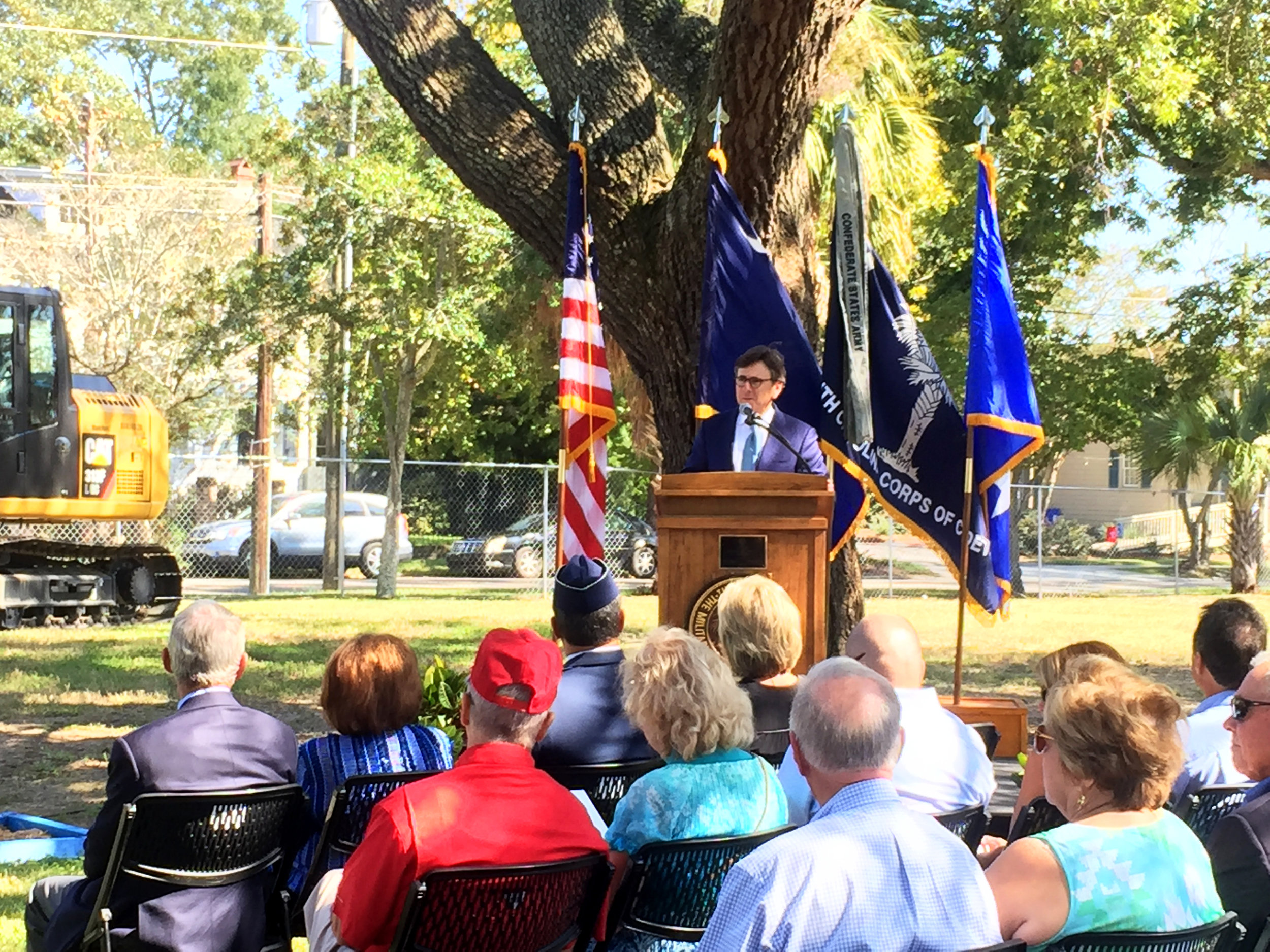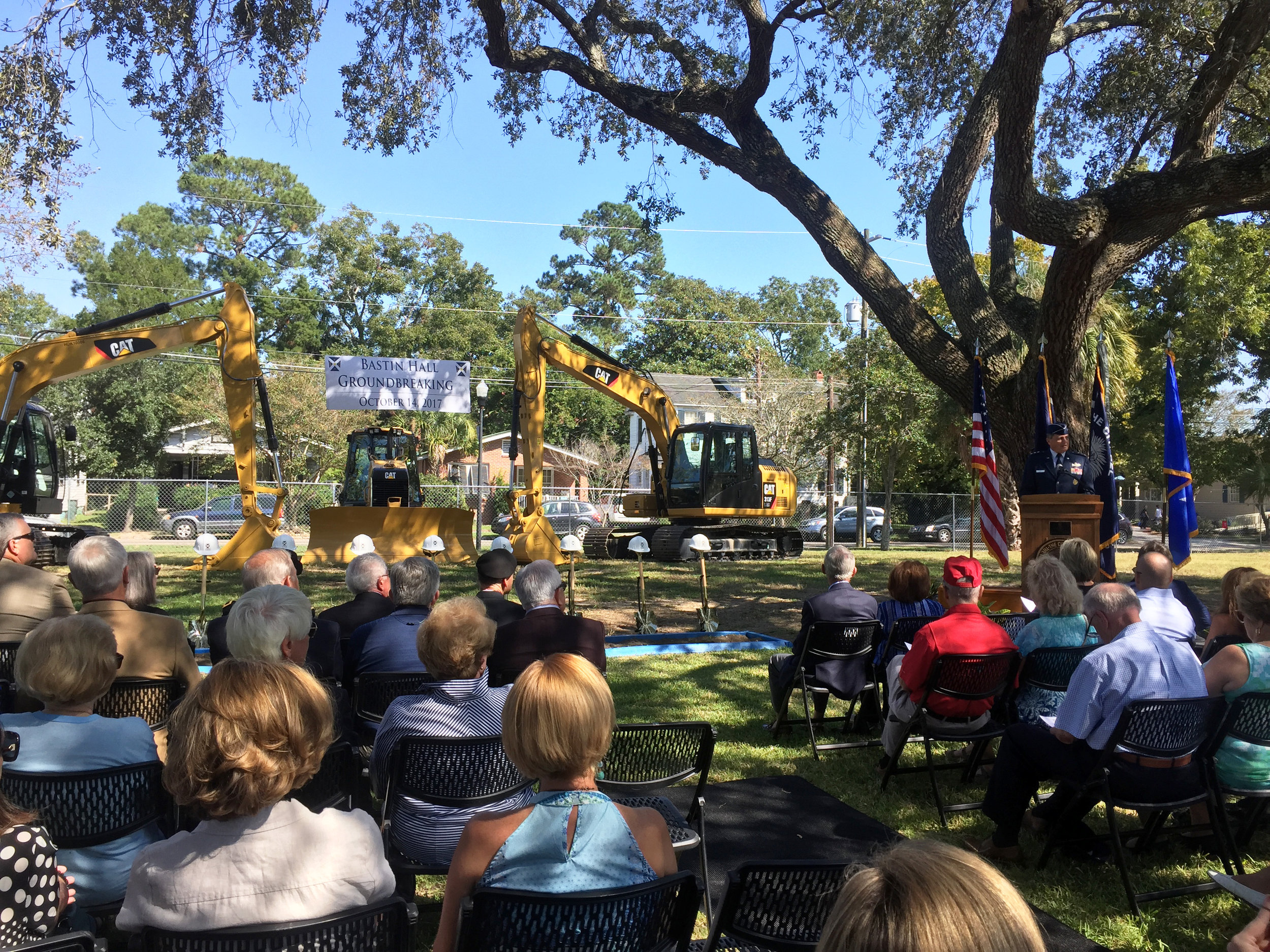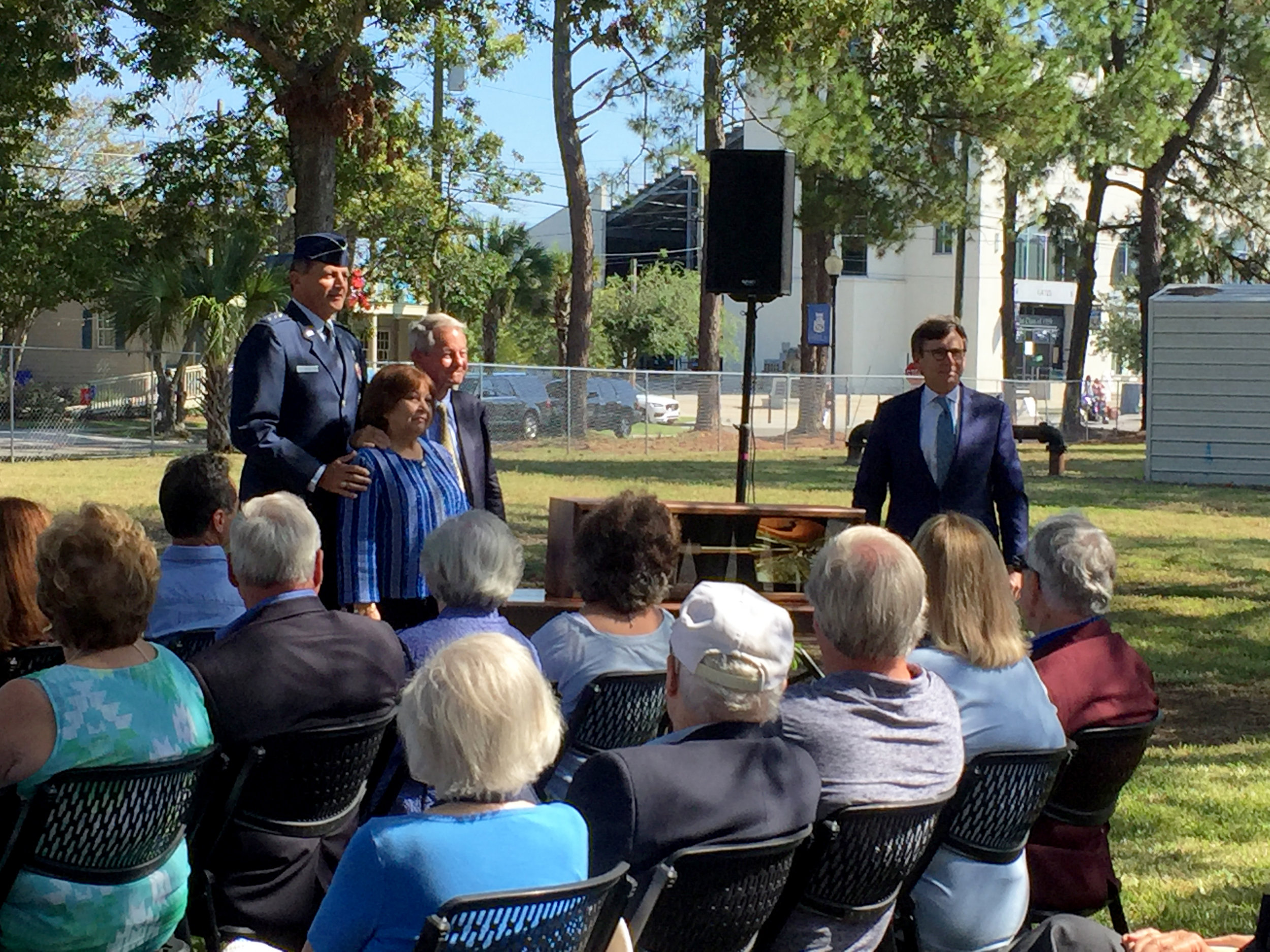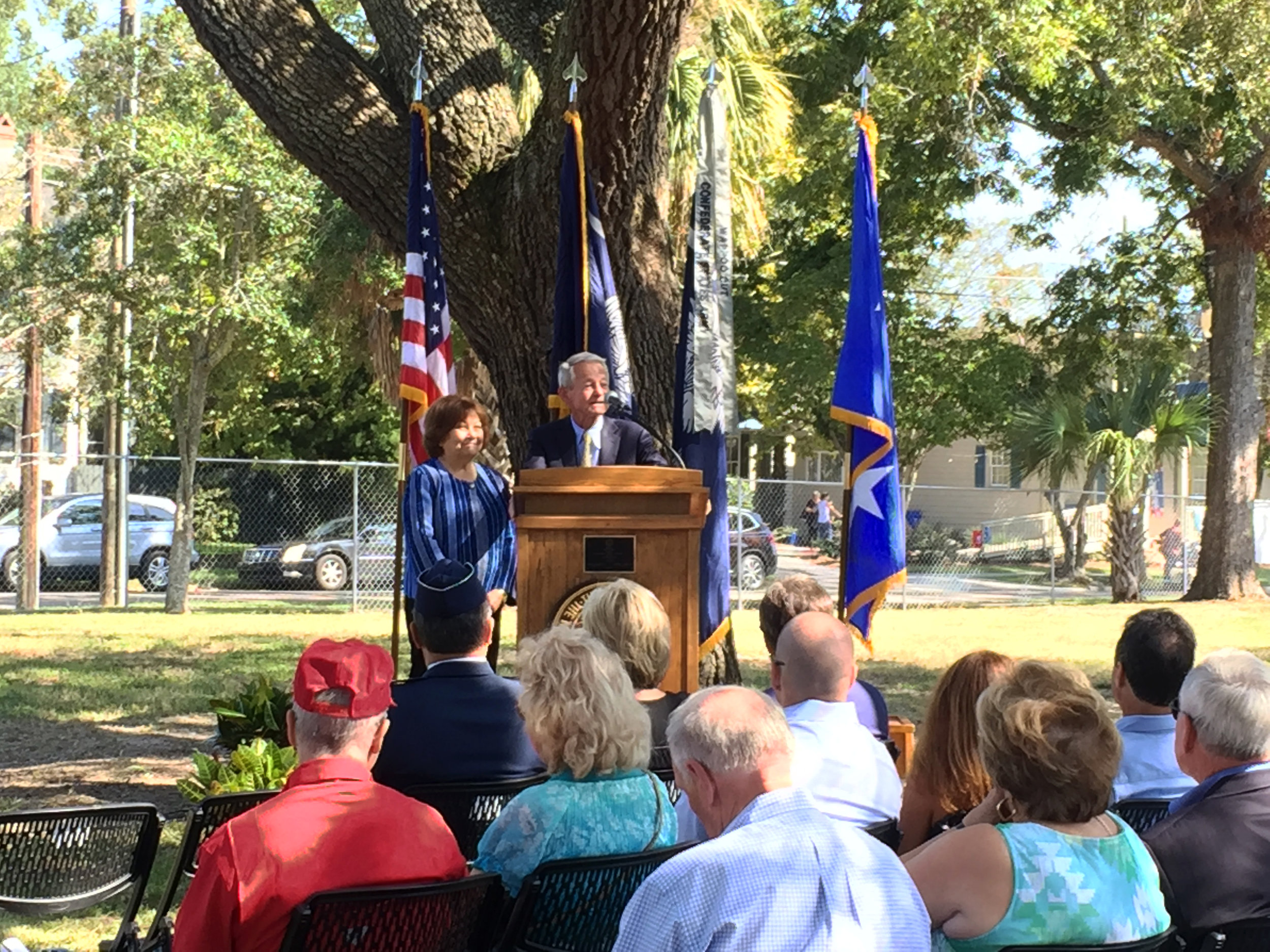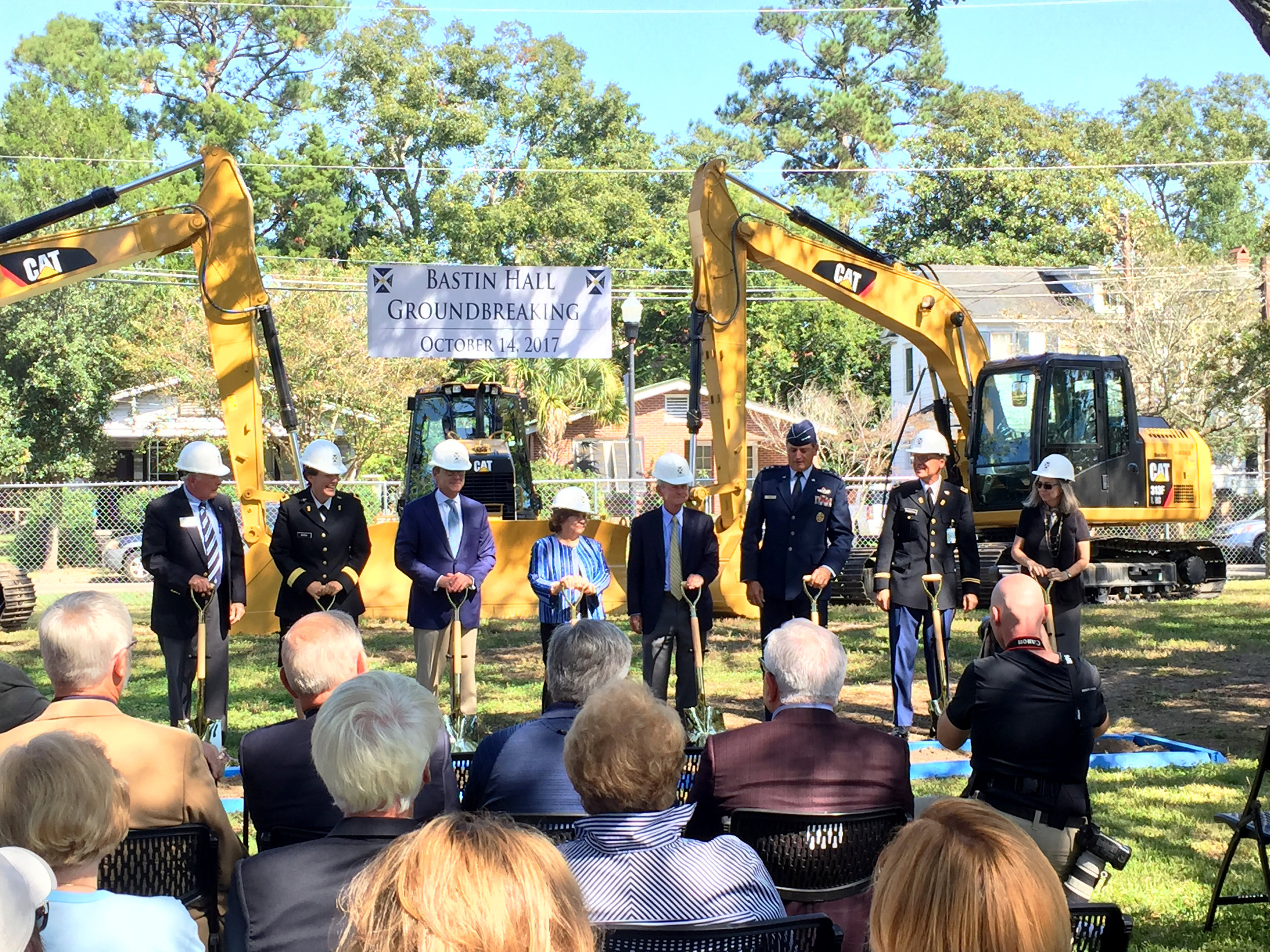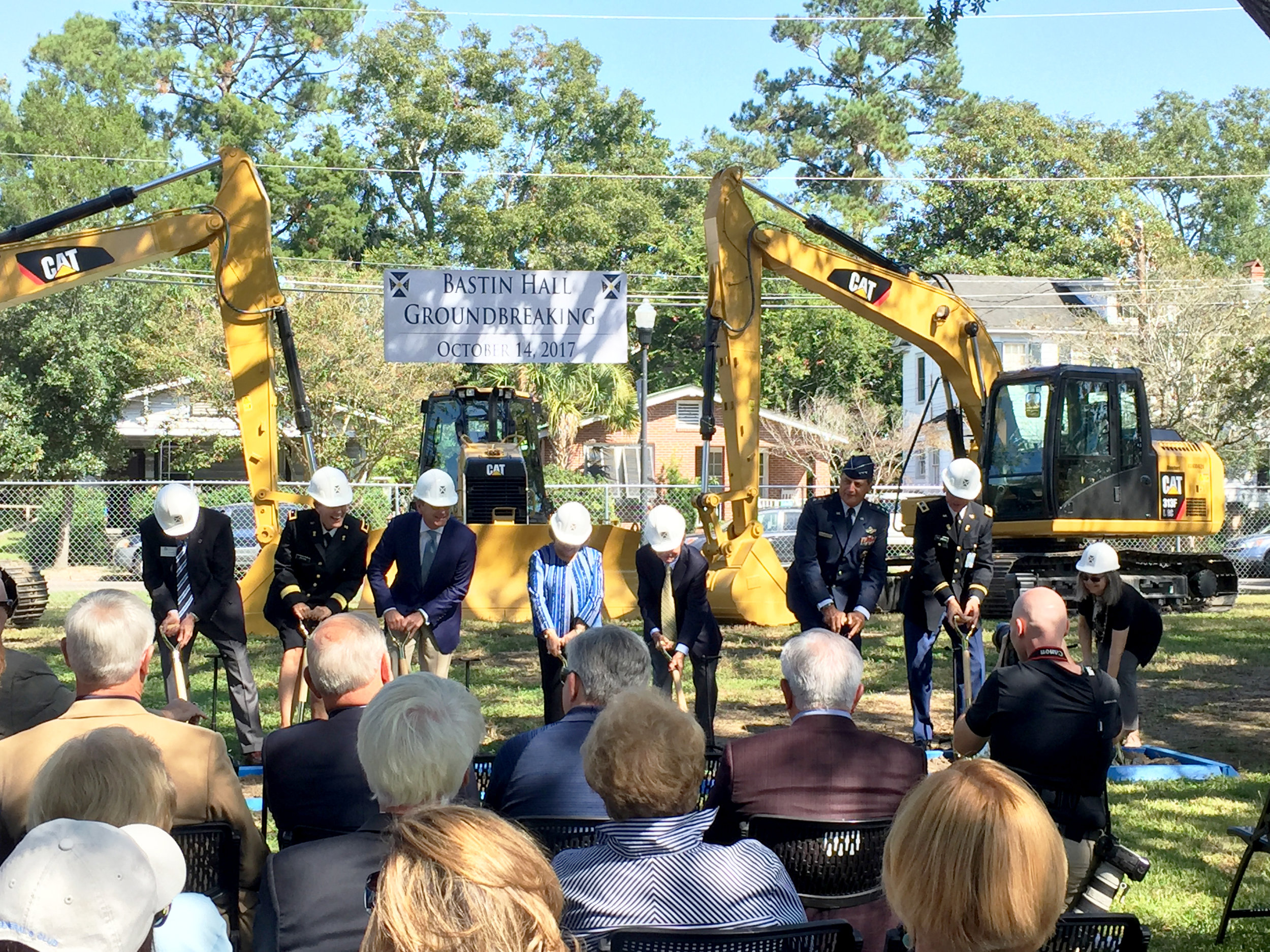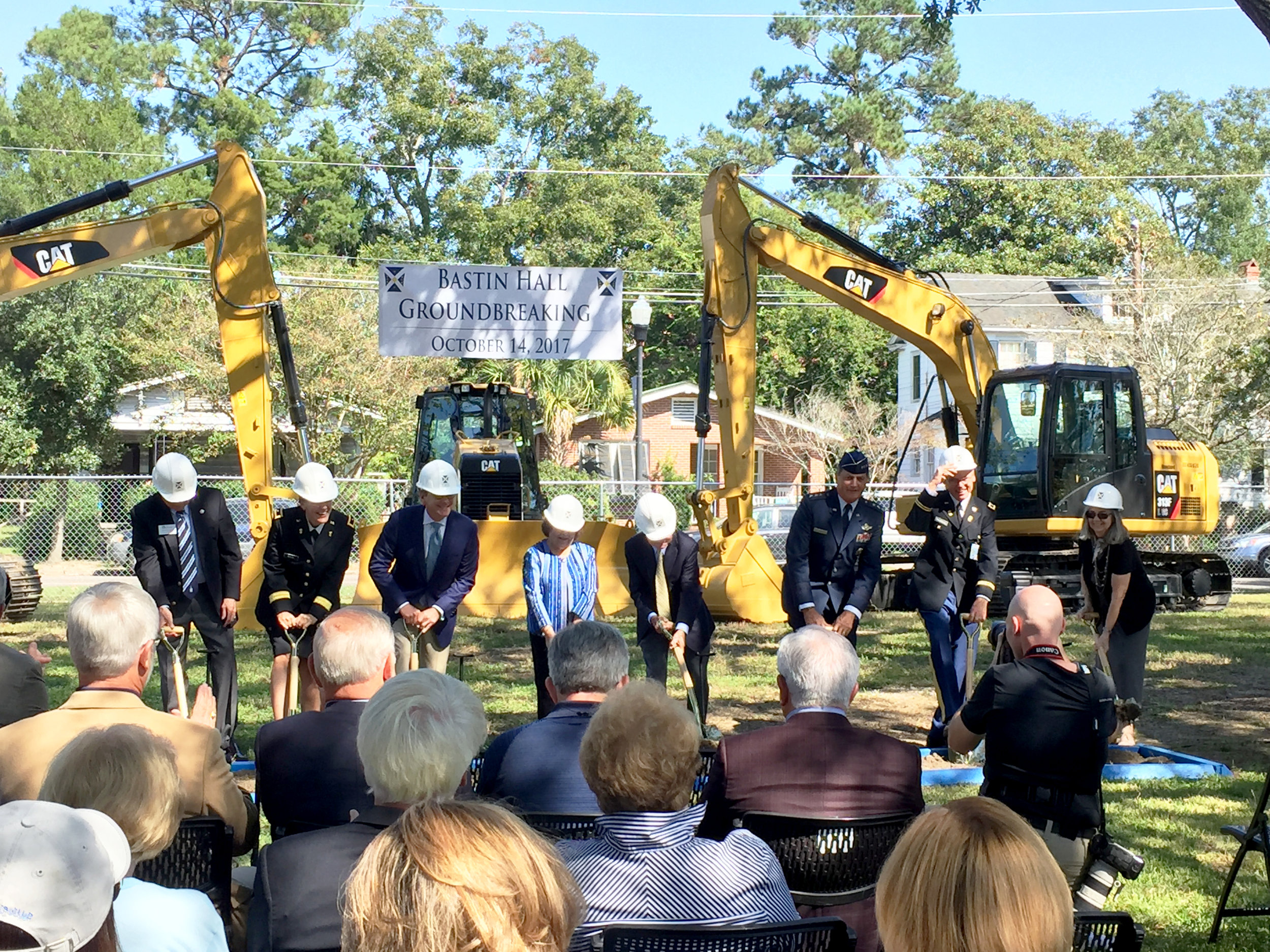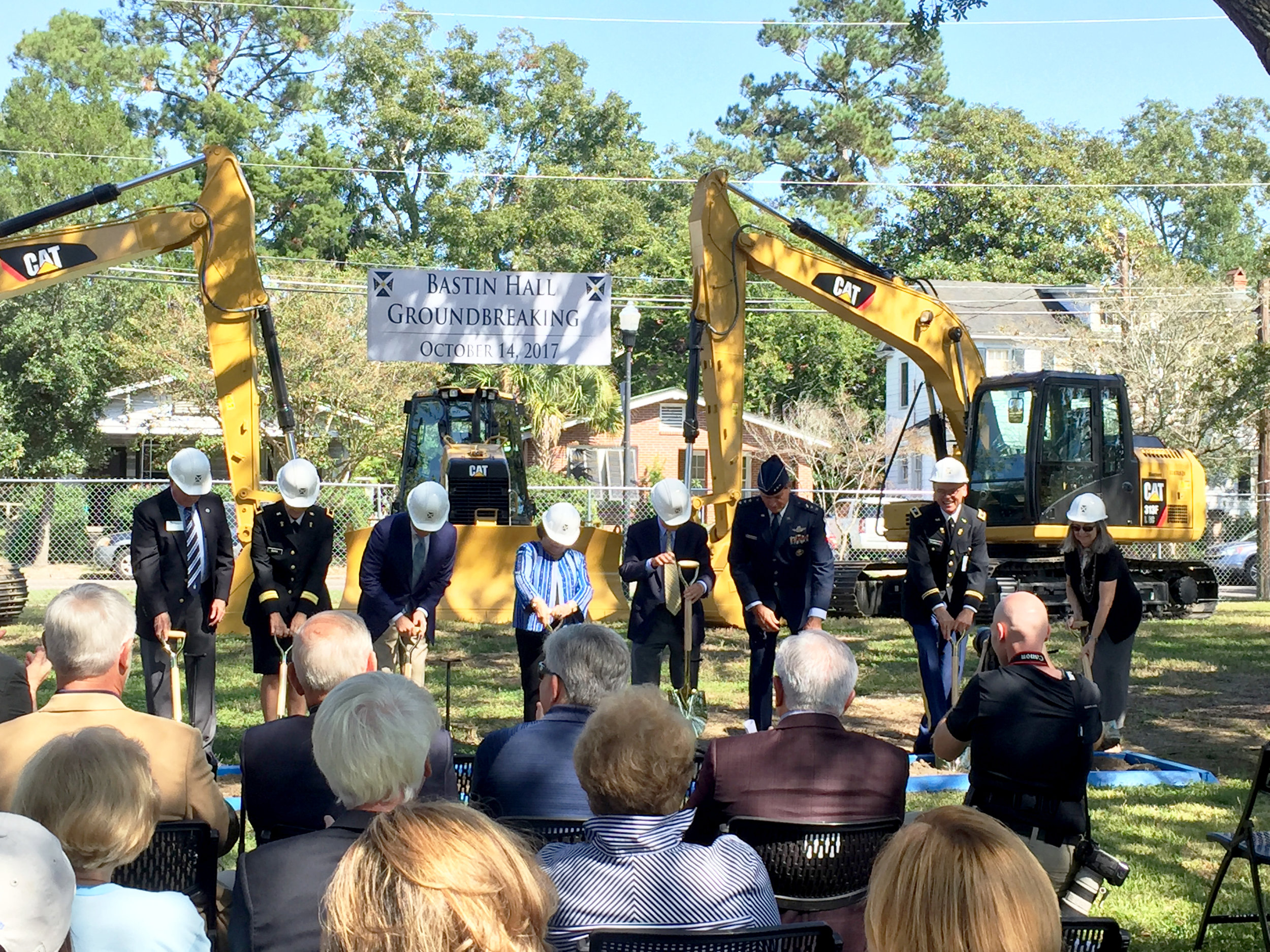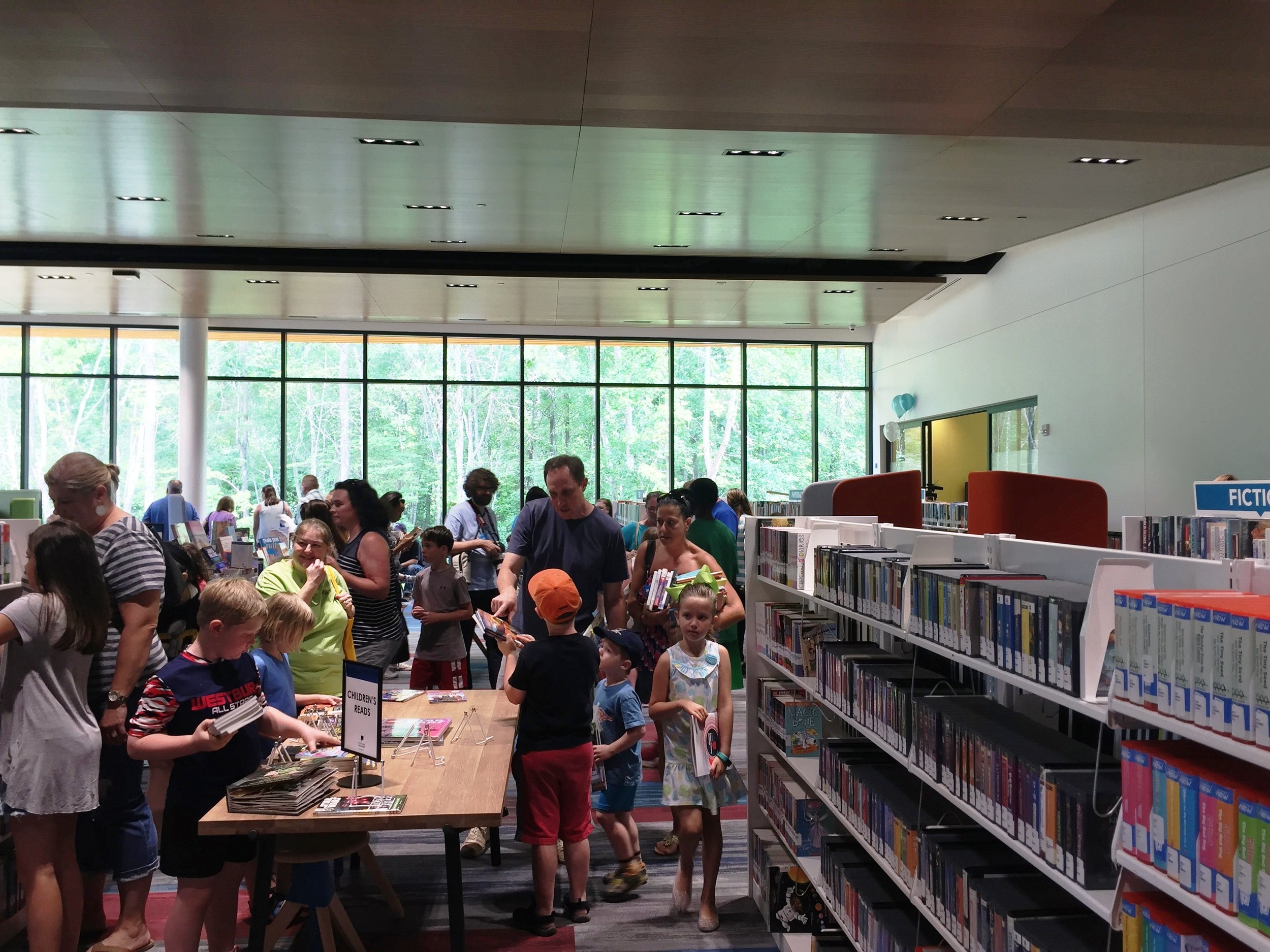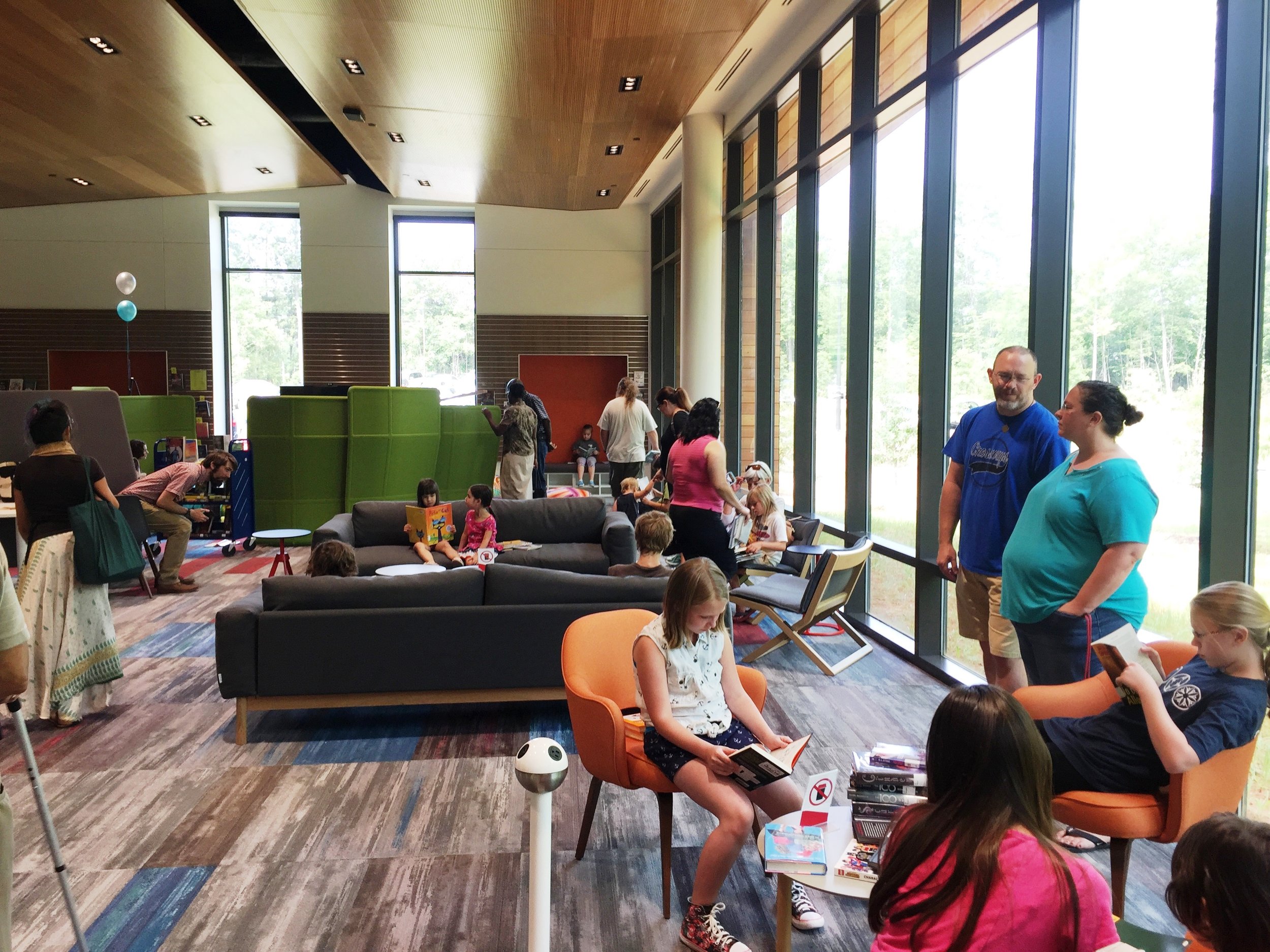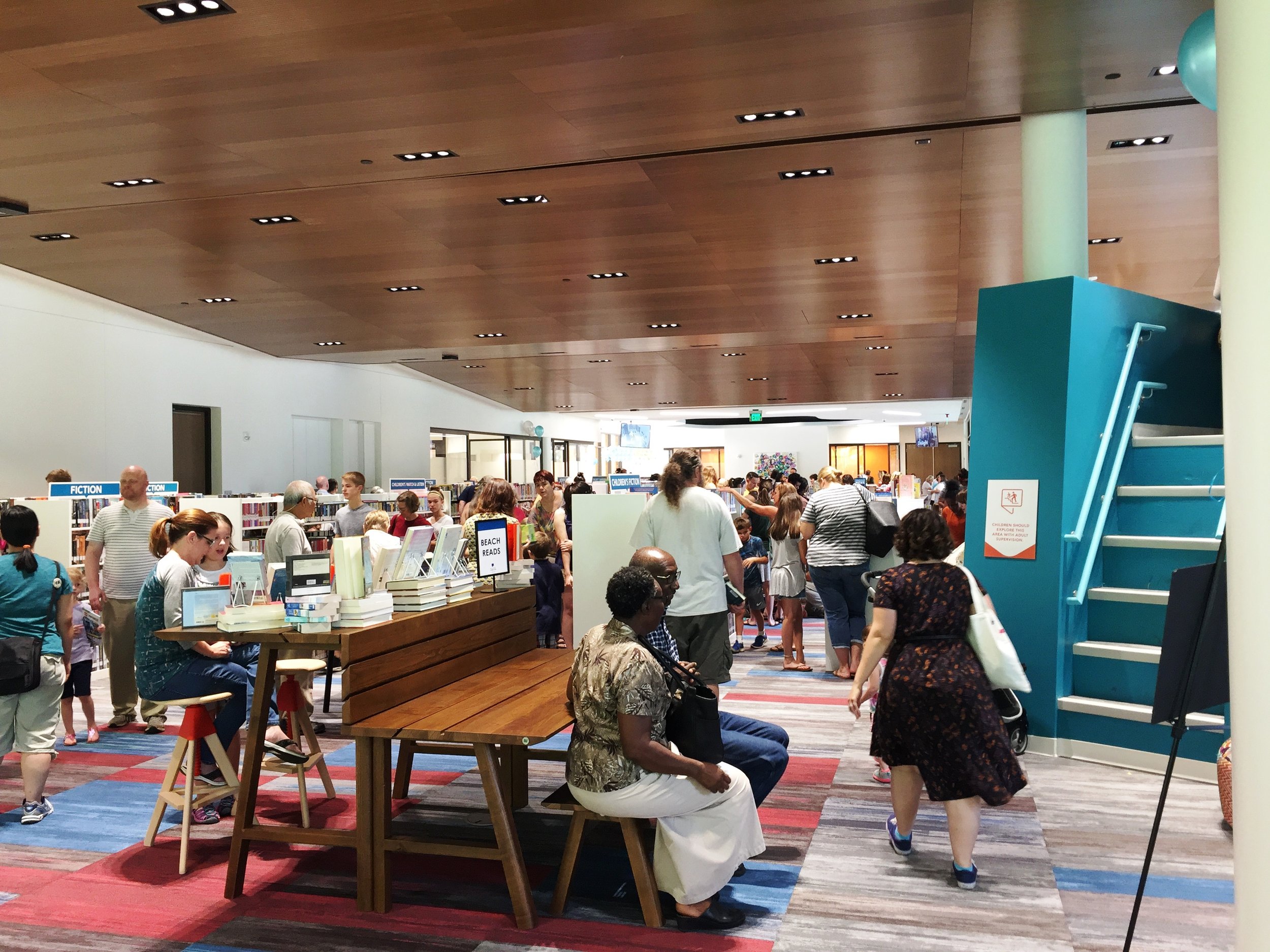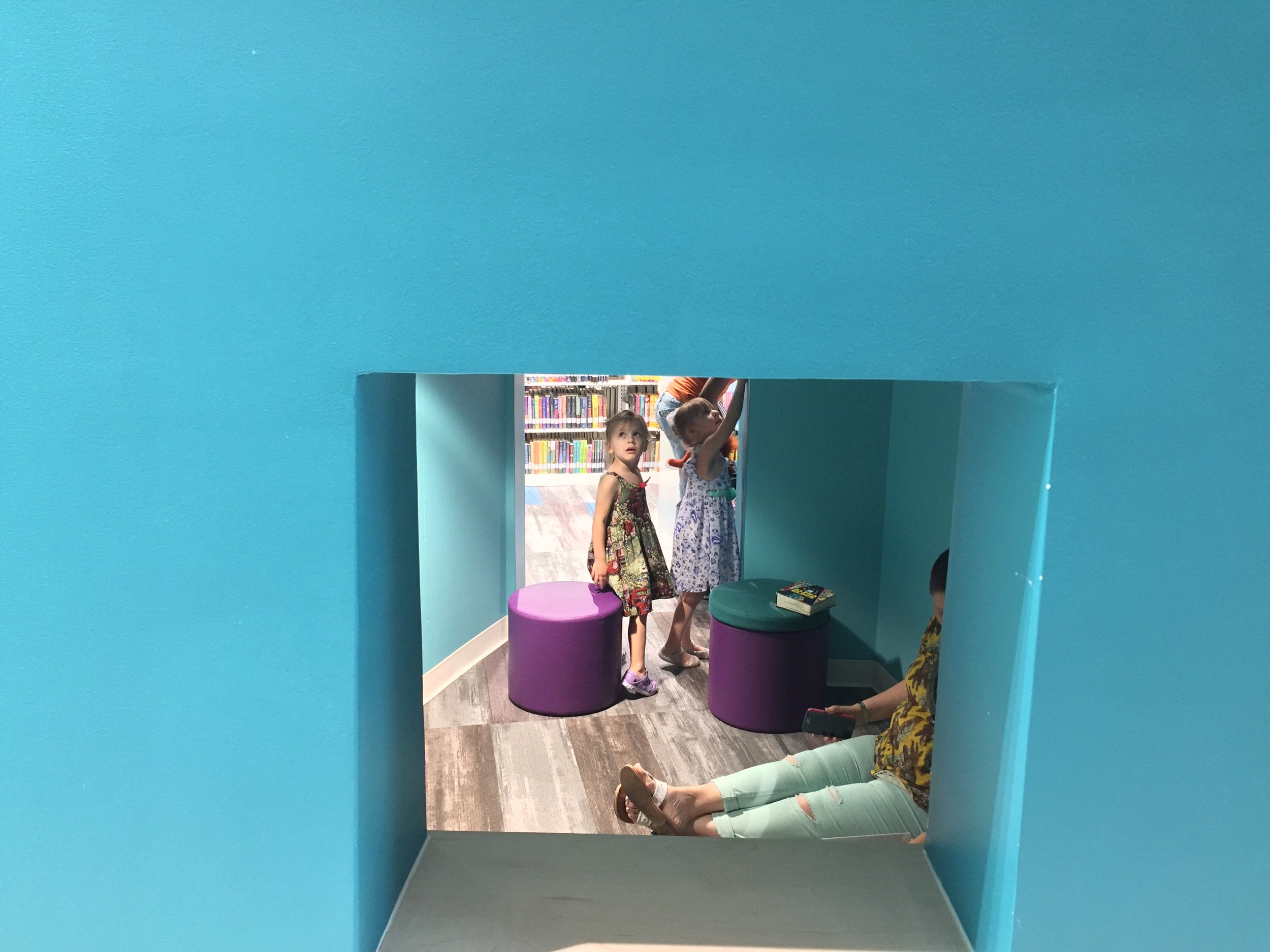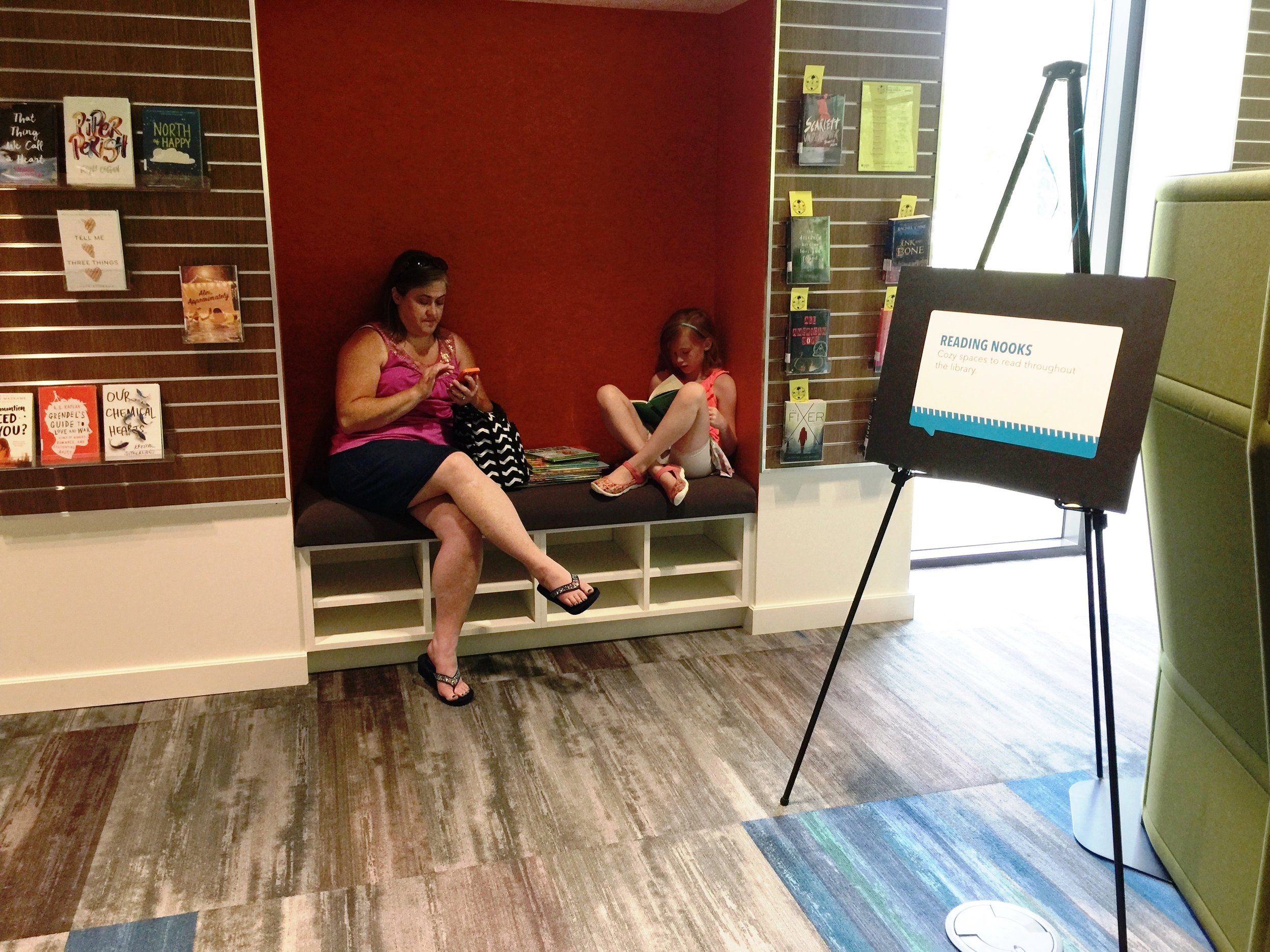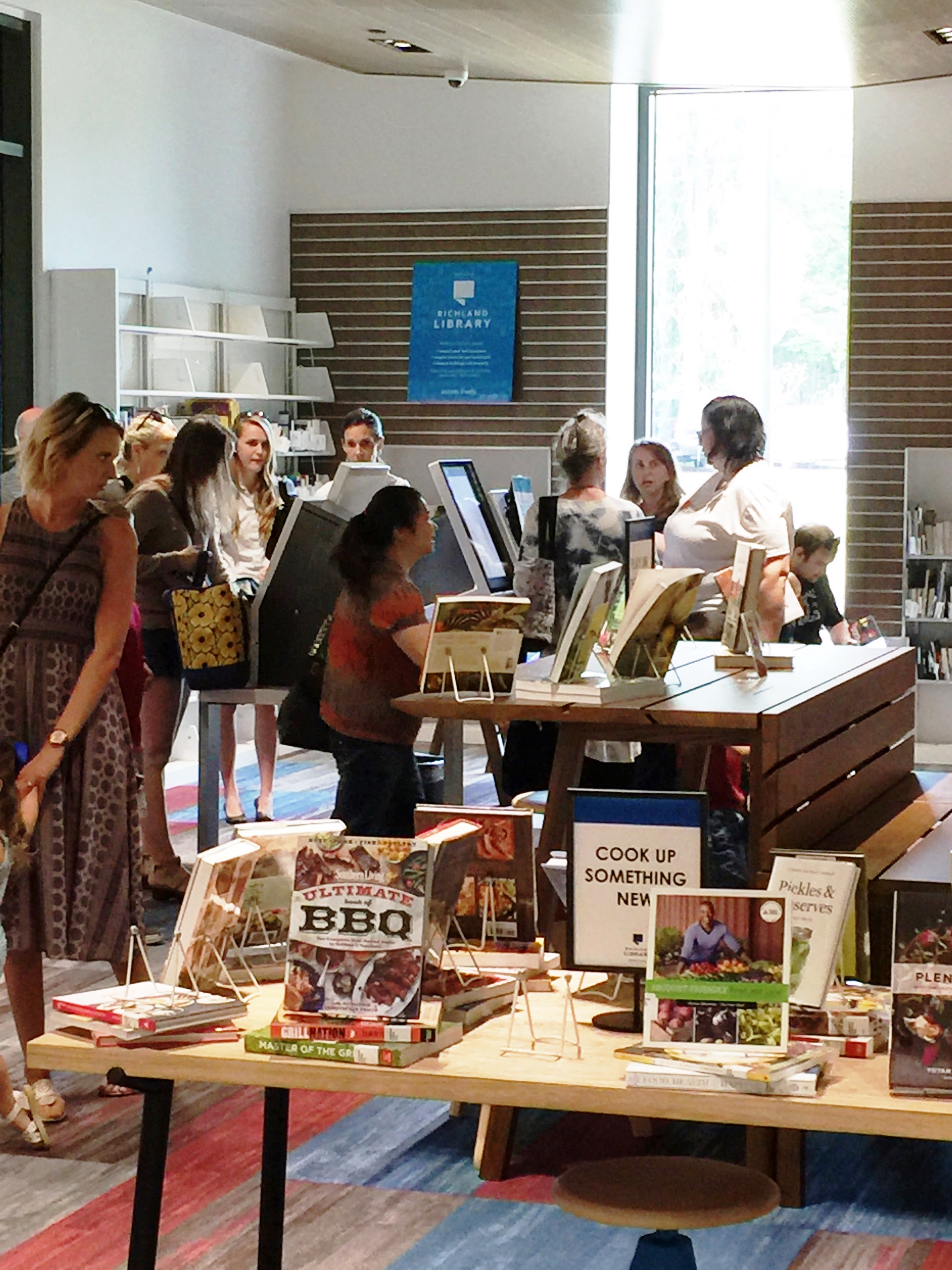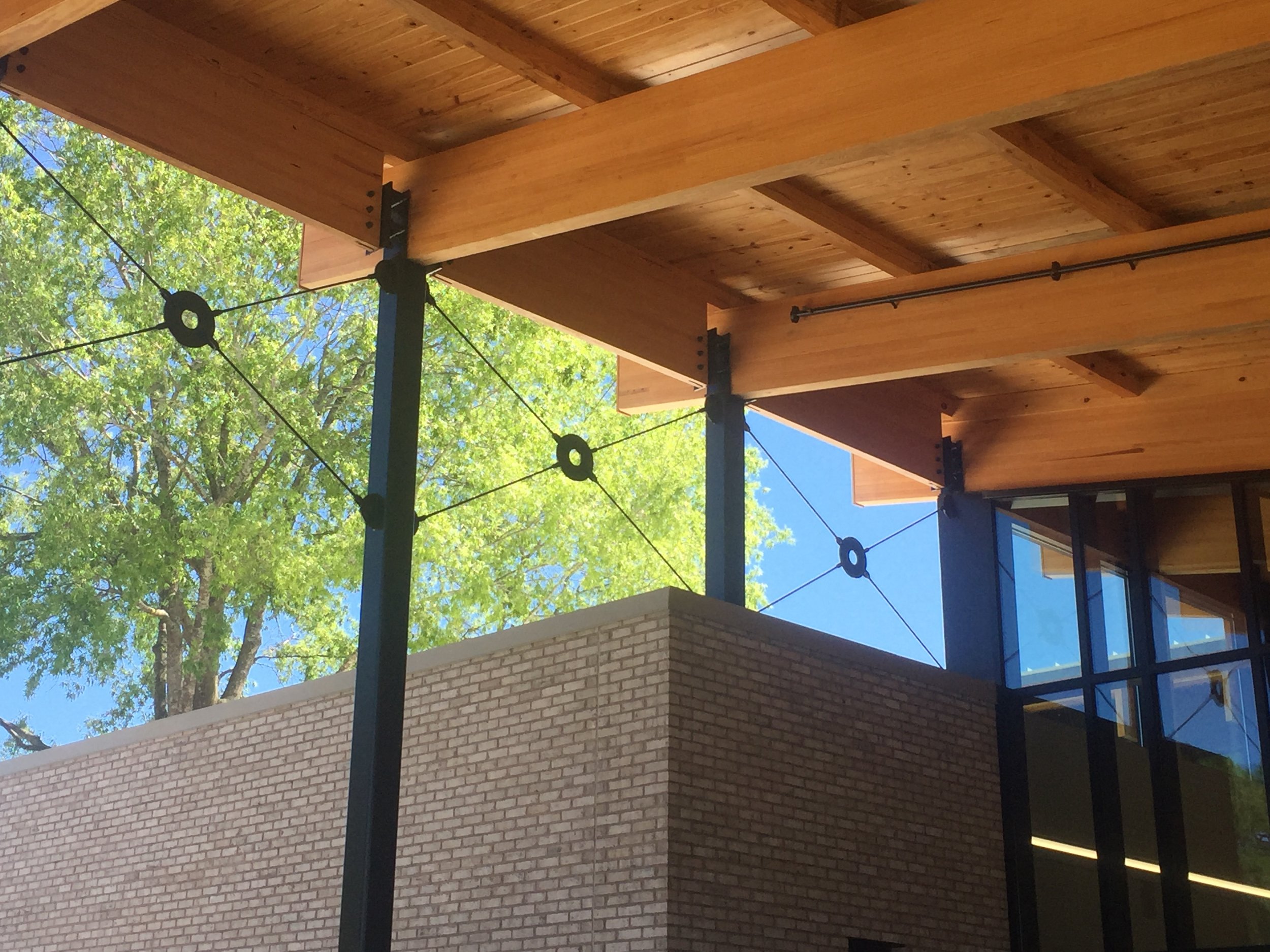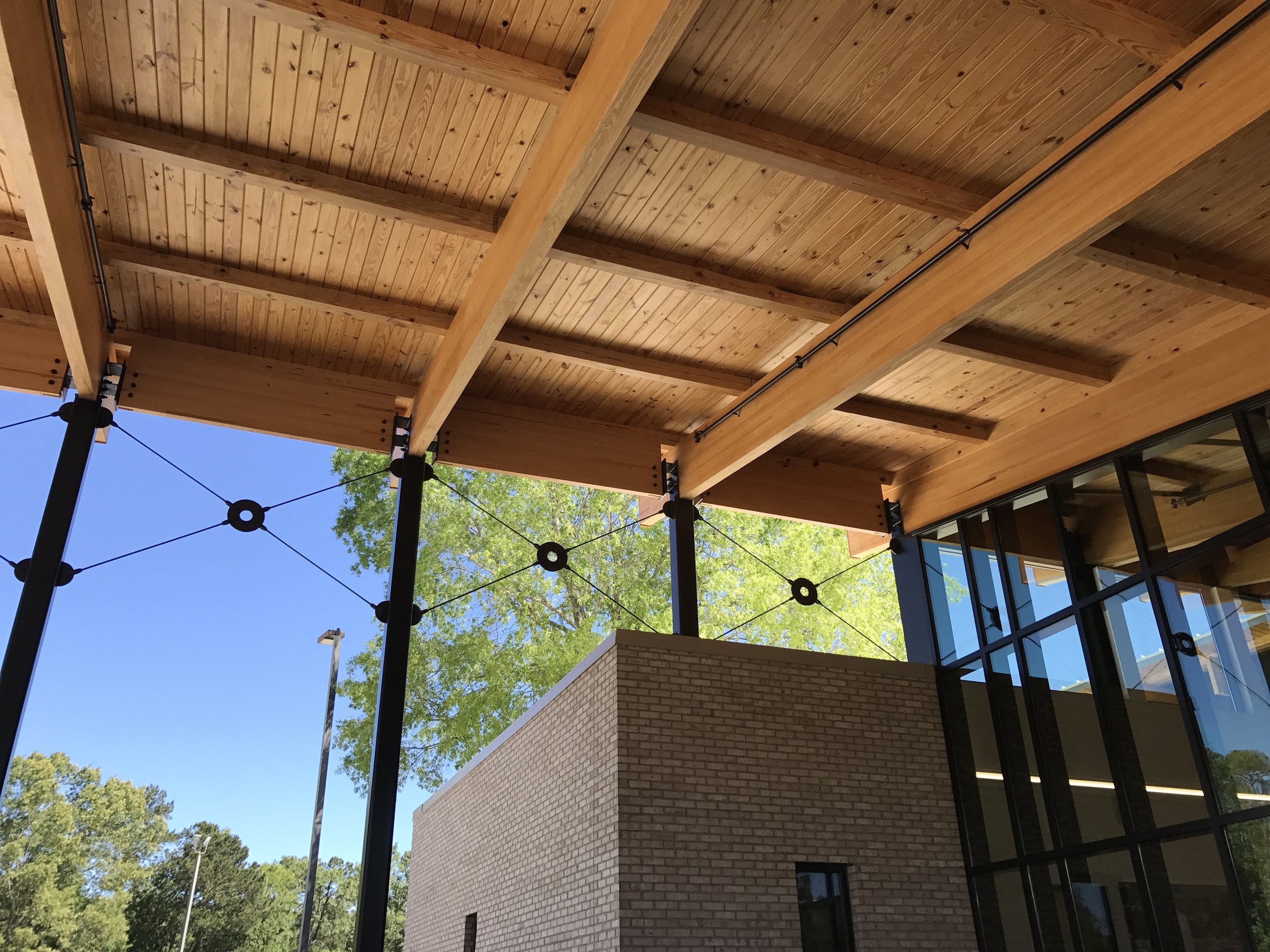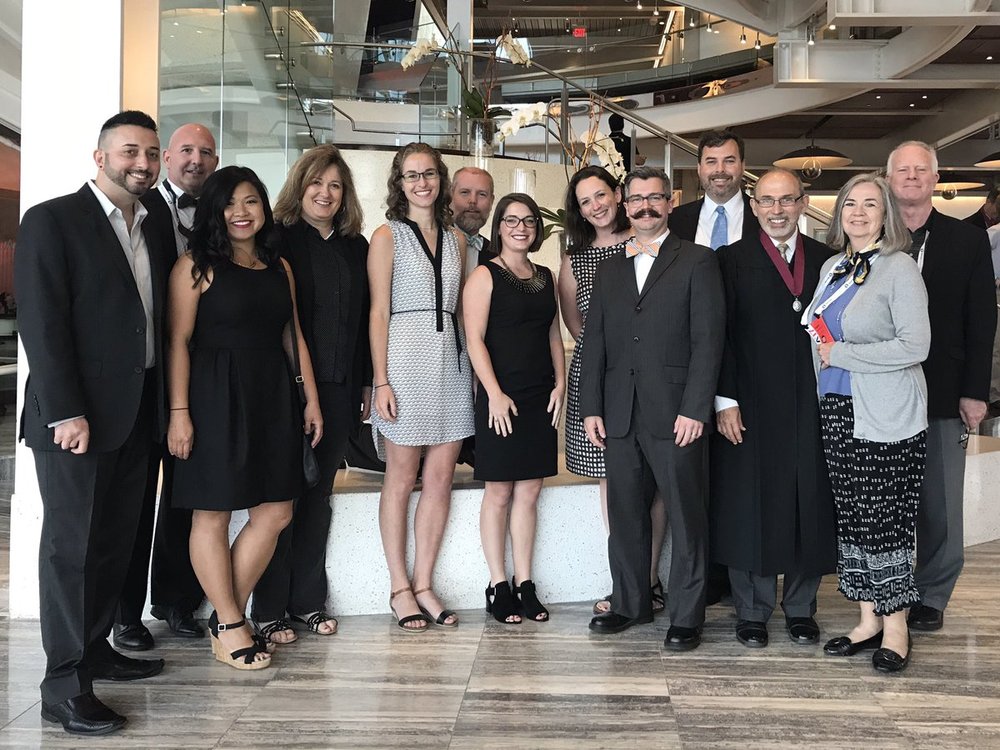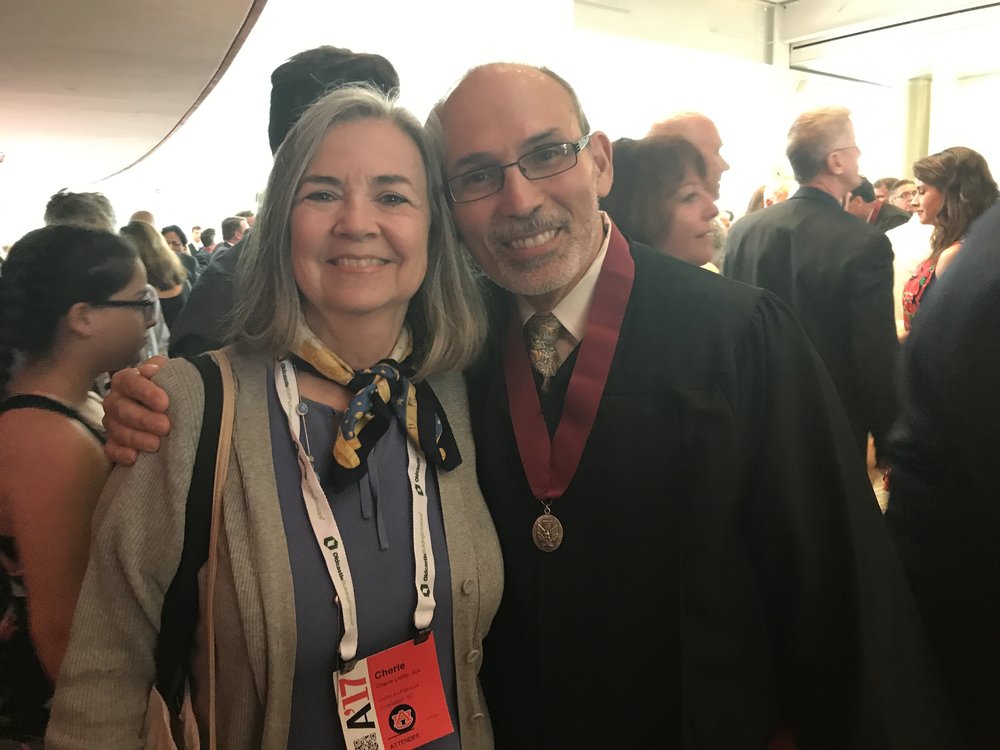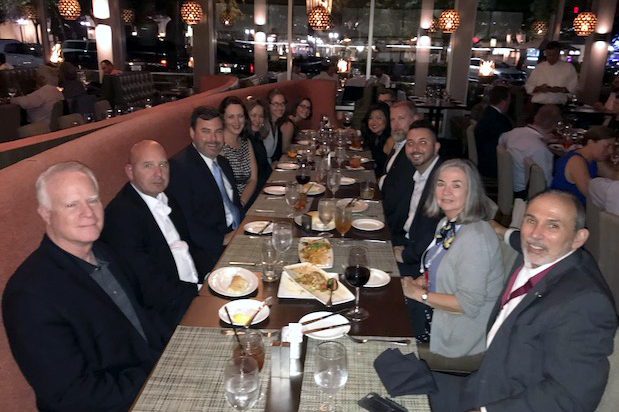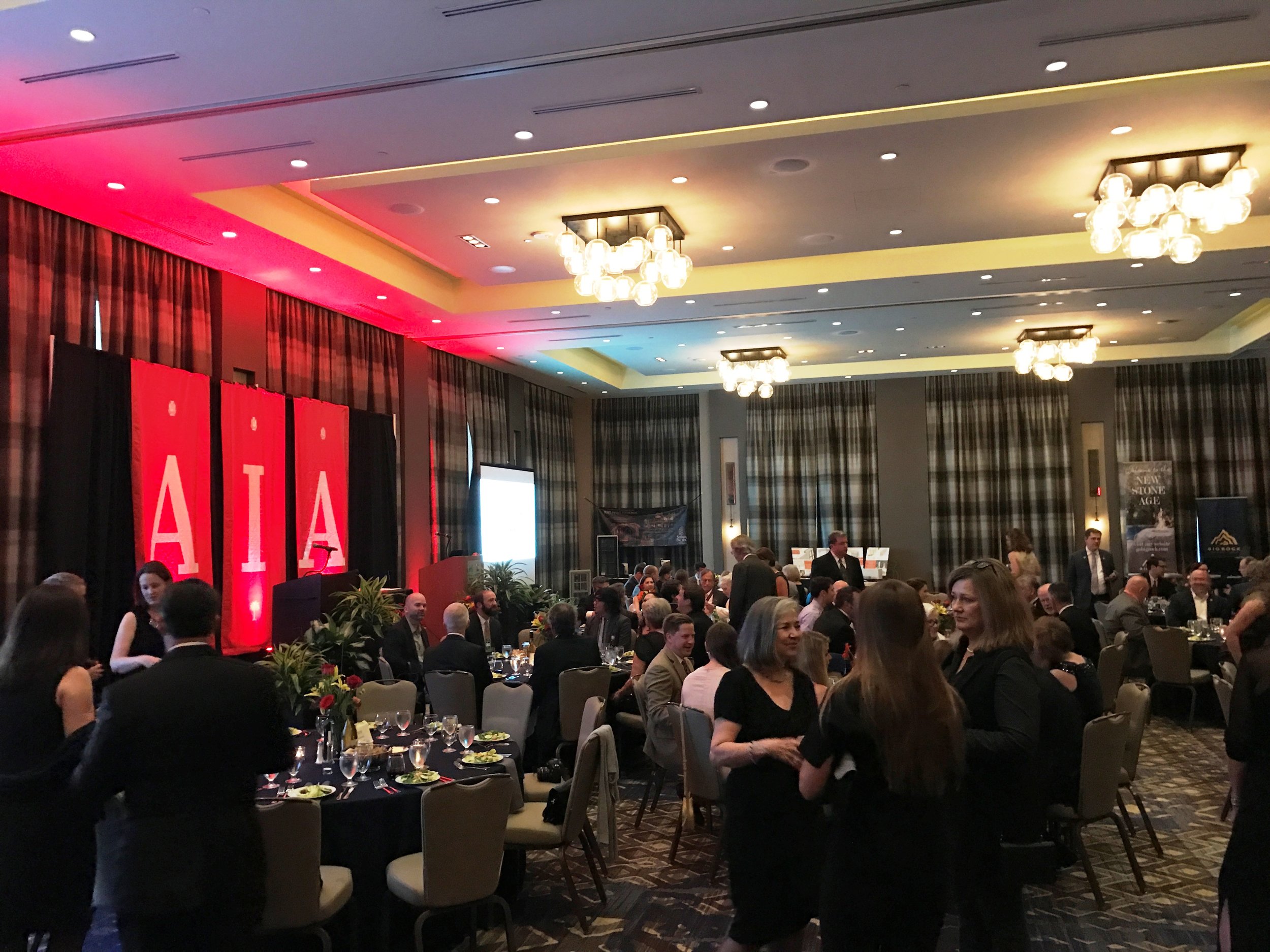
News
Filtering by Category: News
The Citadel Bastin Hall Groundbreaking
Mez Joseph
The Citadel recently broke ground on a brand new academic building. Bastin Hall will be the future home of the Tommy and Victoria Baker School of Business. The building is named after Rick and Mary Lee Bastin, who gave a generous donation to kick-start the fundraising for the building. The groundbreaking, which took place outside of Hagood Avenue, is part of The Citadel's Foundation's Leaders in Philanthropy Weekend. This celebrates the contributions from people who have supported the college's mission of achieving excellence in education.
Liollio, in association with Ikon.5 has designed a 43,000 SF building that will feature a rooftop terrace, eight flat and tiered classrooms, four interview rooms and a 2,100 SF common area. This three story facility will modernize the business education program to prepare cadets to become leaders in the business community. The design is sited to create a new quad of The Citadel campus and becomes a new public face to the City of Charleston. Honoring the tradition of The Citadel and respecting the architectural character, the design incorporates modern characteristics showing the institutions transition into the 21st Century with an optimism for the future.
Liollio's Kendall Roberts Achieves Architectural Licensure
Mez Joseph
Liollio is pleased to congratulate Kendall Roberts, AIA, for earning his architectural licensure and becoming a member of the American Institute of Architects (AIA), a professional organization for architects in the United States. A registered architect must complete an internship and pass a rigorous series of examinations offered by official architectural registration boards in the United States and Canada. The Liollio team celebrates Kendall and his achievement.
Born in Reading PA, Kendall grew up in Greenville SC. He moved to Charleston and joined the Liollio team in 2015 after finishing both his undergraduate and graduate studies in Architecture at Clemson University. Kendall also completed a semester in Barcelona at the Barcelona Architecture Center through Clemson’s Fluid Campus Program. He was on Clemson’s Solar Decathlon Team in 2015, and served as President of Freedom by Design (Clemson AIAS Chapter) during his undergraduate program. Freedom by Design, the AIAS community service program in partnership with the National Council of Architectural Registration Boards (NCARB), uses the talents of architecture students to radically impact the lives of people in their community through modest design and construction solutions.
Kendall’s project work at Liollio has ranged in size and scope, strengthening his design, attention to detail, communication and collaborative skills. His recent work includes Charleston Fire Department’s Station 11, the Louis Waring, Jr. Senior Center, and the Kiawah Island handrail replacement at The Preserve.
Doug Kelbaugh, FAIA Presents Inaugural Lecture at MRUD Program Charleston
Mez Joseph
Clemson's School of Architecture is pleased to announce the inaugural lecture for the Master of Resilient Urban Design program in Charleston SC. Doug Kelbaugh, FAIA is the Emil Lorch Collegiate Professor of Architecture and Urban Planning and Dean Emeritus Taubman College of Architecture & Urban Planning. For additional information on this lecture and the MRUD program, please contact: B.D. Wortham-Galvin, Ph.D., Associate Professor and Director, 843-723-1747, bdworth@clemson.edu. Visit the Clemson School of Architecture news & events page here.
Built, Fast! 6 Local Architects Talk Shop
Mez Joseph
Associate Principal Andy Clark recently attended AIA Charleston's Pecha Kucha presentation Built, Fast! 6 Local Architects Talk Shop on July 18 held at Charles Towne Fermentory. Andy presented Liollio's design of the University of South Carolina Beaufort - Hilton Head Hospitality Management Facility. The project is currently under construction and Liollio is working in association with Bialosky Cleveland. Six local architects discussed and displayed images of their work at the new brewery in Avondale. The event was presented by AIA Charleston and CRAN Charleston, but was open to all. Each presenter exhibited 20 slides for 20 seconds each. It was a concise presentation of what our local architects have been hard at work on. Visit the AIA Charleston website at www.aiacharleston.com for upcoming events.
Finlay Park Receives Honor Award for Analysis & Planning from ASLA Southeast Regional Conference
Mez Joseph
The American Society of Landscape Architecture (ASLA) recently held their Southeast Regional Conference in June where they announced the 2017 design award winners. Finlay Park Master Plan in Columbia, South Carolina won an Honor Award in the Analysis and Planning Category – among the top awards for the program. The City of Columbia and the design team, which includes Stantec, Civitas, Liollio Architecture, HR&A Advisors, Cox & Dinkins, Chao & Associates, Cumming, Comprehensive Business Consultants, and Georgia Harrison received the award.
Directly across from the Governor’s Mansion, Finlay Park is an 19-acre urban park offering some of the most dramatic vistas of Columbia’s skyline. Once a thriving urban park, the city has seen Finlay decline over the years which can be attributed, in part, to structural failures in walls, leaking water features, non-compliance with building codes leading to risk and safety concerns, and accessibility. Created through a process of analysis, public involvement and meaningful design, the following goals guided the master plan:
- Accessibility
- Unique destination playground
- Increase safety and visibility
- Rebuild the walls and leaking water features
- Projection of sound
The plan balances the introduction of new elements with the unique forms and charm of the original park. Iconic elements within the park are to be refurbished, such as the spiral fountain which is much loved and holds the historic character of the park.
Stantec led the design team, and facilitated focus group and public meetings to gain consensus from community and business leaders, city staff, and emergency responders. Through these meetings, Stantec gathered information on park programming, revenue resources, safety, maintenance, access, and community needs. Ultimately, the design team established design principles and goals to guide the final master plan. The project will move into construction once funding is secured.
The regional ASLA Awards is an annual design competition that recognizes the best in landscape architecture. The program is administered by North Carolina, Georgia, and South Carolina ASLA Chapters. The jury was from outside of the Southeast Region and the entry is anonymous. Liollio is proud to be part of the Stantec design team for this award-winning project. Congratulations to all on the team!
Charleston Airport Lauded by Peers for Terminal Improvement Work
Mez Joseph
Liollio is proud to be part of the Fentress Architect design team for the award-winning Charleston International Airport Redevelopment.
Charleston International's peer airports across the Southeast recently lauded the gateway to the Lowcountry for outstanding architectural renovation following the $200 million terminal improvement project.
The Southeast Chapter of the American Association of Airport Executives presented the best Commercial Service Airport – Architectural Project award to Charleston during its conference in Knoxville in April. The group represents more than 550 members and 88 airports in the southeastern U.S.
“This award is a testament to the hundreds of people who worked on what is a total transformation of Charleston International Airport, from the architects and designers to the construction crews to the Aviation Authority staff that oversaw the day-to-day planning and progress,” said Paul Campbell, executive director and CEO of Charleston County Aviation Authority, which oversees the airport.
Read the full Post & Courier article here.
East Cooper Meals On Wheels
Mez Joseph
Thank you Palmetto Tile Distributors for creating SpecSC, a wonderful program that allows local companies to designate a portion of their purchase to local non-profits! Liollio's Elissa Bostain & Mary Tran stopped by to visit the East Cooper Meals on Wheels facility and meet with Palmetto Tile's Jason Goldberg and Sara Holt to present ECMOW with a check. Click here o learn more about the Palmetto Tile Distributors SpecSC program. Find out how you can help East Cooper Meals on Wheels here or by clicking the image above.
Fire Station #11 Near Charleston 9 Memorial Coverage on ABC News 4
Mez Joseph
CHARLESTON SC (WCIV) by Bill Burr— "We call it the little big house because of our location. We actually run quite a few calls," explains Captain Donovan Richardson of the Charleston Fire Department. He works at Fire Station 11 on Savannah Highway near Markfield Drive where firefighters live and work in close quarters.
"The rowing machine will get pulled out and we'll slide the work bench out a little bit when those guys are doing their reps," says Richardson. He shows how a dormitory for sleeping is also used as a gym. It’s one of the challenges of using a building built more than 50 years ago.
"They've added a battalion chief medical locker which takes up a lot of space. That same space holds all of our gear whenever we're not here. So, we have two other shifts. And we've reached our capacity with the number of guys," Richardson said.
Fire officials say the station was built in 1961. Since then, service needs have increased. That’s why interim fire chief John Tippett says the fire department plans to build a state of the art fire station just blocks away from Station 11, and next to the Charleston 9 memorial. It'll feature classic architecture, including nine windows symbolizing the firemen who died at the Sofa Super Store. "That property being next to the memorial site I think will add another depth of the improvements in the area, the recovery of the department since the fire, and where we're going as an organization," Tippett said.
It’ll be an upgrade in facilities and technology for members of Station 11’s Westside Battalion. The current fire station has 4,000 square feet of space. The new building will have about 14,000 square feet to accommodate up to two companies of firefighters, a command training center, and storage space for frontline and spare apparatus.
A price tag for the new station hasn't been determined. The city's design and review board approved the plans Monday night. Other boards will need to approve them, too. Interim Chief Tippett says the goal is open the new fire station by the end of 2018.
Images From the Richland Library Ballentine Opening
Mez Joseph
New Ballentine Library Debuts
Mez Joseph
Tim Flach
tflach@thestate.com
The new Richland County library in the Ballentine area will be more than a place for children to read. The facility at 1200 Dutch Fork Road, which opens Tuesday, includes a tree house and puppet stage for play and other activities as well as perusing books, watching videos and scanning the internet.
At 13,000 square feet, the $5 million library is four times larger than the former storefront it replaces. The facility on the north side of Lake Murray is the second new library built through a $59 million bond issue approved by Richland County voters in 2013.
The expanded Blythewood branch reopens June 22.
Watch The State Newspaper video coverage and read full article here.
Blueprint for Business: SC Architects on the front line of a Building Boom
Mez Joseph
Warren L. Wise
843-937-5524
wwise@postandcourier.com
Drive down any major street in South Carolina’s largest cities, and it’s not hard to miss the mass of workers in hardhats or the construction cranes towering over once-vacant lots. From apartments to hospitals and hotels to homes, the building boom is at full throttle.
But before any of those structures get off the ground, they need a blueprint. That’s where architects come in.The people who draw up plans and pencil in details sit on the front line of the economic upswing enveloping the country, and many are busier than ever.
Firms with offices in Charleston and projects across the state and elsewhere say workloads are healthy, competition is steep and the foreseeable future shows no signs of a slowdown.
“The Southeast is hot,” said Tom Hund, a principal who leads the Charleston office of Greenville-based McMillan|Pazdan|Smith Architecture. “It’s one of the best growth zones in the country. It’s quality of life. It’s manufacturing. It’s retirees. And when you narrow it down regionally, the Charleston region is leading the charge.”
He pointed to diversity in the growth of manufacturers such as aerospace and automotive suppliers along with upticks in housing, retirement communities, resorts and tourism as all contributing to the demand.
“In all of those markets, there is great activity,” Hund said.
“We were once known as a tourist city and nowwe are known as a manufacturing and tech city, too,” Hund said of Charleston. “As one market may grow, another may slow, so we have an opportunity for balance. I see a really nice diversity here.”
Marc Marchant, leader of LS3P Associates Ltd., a regional firm based in Charleston, characterized the design market across South Carolina as “shifting into high gear.”
“We are all optimistic about the future and continued growth,” he said, pointing to expansion of the automotive sector near Charleston, a tire manufacturer coming to Orangeburg and continued industry expansion across the Upstate. “I think there is plenty of room for more growth.”
At Liollio Architecture of Charleston, which focuses primarily on public-sector projects, principal Dinos Liollio is bullish on the market across the state and the region.
“I think it’s strong, and I’m very optimistic that it will remain strong,” Liollio said. “Even with a little bit of increase in interest rates, I don’t think it will disturb the building program. Public entities and foundations are in pretty good shape to invest in a robust building program.”
The Midlands market is “robust” as well, according to Doug Quackenbush, president of Quackenbush Architects + Planners. His Columbia f irm handles publicsector projects such as schools, where work is more steady than the cyclical nature of private-sector buildings such as apartments, hotels or office buildings, but in talks with colleagues working with pr ivate- sector desig ns, Quackenbush said, “It seems like right now both are prettyhealthy.”He believes escalating construction costs will eventually lead to a slowdown, especially in the private sector, but the need in K-12 education is so great across the state, the explosion of work will continue.
Among some of the projects Quackenbush is now working on are two elementary schools in Rock Hill, a renovation and addition to an elementary school in the Conway/Myrtle Beach area and an addition to a middle school in Chapin near Columbia.
Quackenbush believes prospects for higher education construction projects are more muddled because of funding restraints, but his firm is involved in the design of the $50 million football operations center which recently broke ground on Bluff Road for the University of South Carolina.
The design and construction market along the Grand Strand shows few signs of letting up either.
“Similar to Charleston, the Myrtle Beach market is growing,” said Marchant of LS3P, which also operates an office in the resort city. “We are seeing more beachfront opportunities, more restaurants and renovations.”
Two of the larger retail projects LS3P is involved with are the redevelopment of Barefoot Landing and Broadway at the Beach.
“They are regenerating the retail experience in many locations, including those two,” Marchant said.
Working with Change
Because of all the construction going on now, Hund said some municipalities, such as Charleston, struggle with how much is too much.
“The architects have to respond to that and remain innovative and creative, which is a challenge,” he said. “The better ones get it done.”
There is so much work, it is putting pressure on the design and construction industries to keep up, architects say. Not surprisingly, clients also are finding it more of a challenge when looking for help, especially for home additions and other smaller jobs.
In Charleston, design is strictly regulated with standards on the cusp of being tweaked, adding another layer to detailed plans. But Hund said proposed changes to the city’s architectural standards actually mean the construction industry is doing so well that new guidelines merit attention.
“That all points to a booming economy and efforts to preserve a quality way to design,” he said. “We want to contribute to our community through the architecture.”
Among the construction projects McMillan|Pazdan|Smith is involved in are the Medical University of South Carolina’s Shawn Jenkins Children’s Hospital, the proposed 225-room hotel slated for the current site of the State Ports Authority’s headquarters on Concord Street, a new high school in Mount Pleasant and retail village at the developing, mixed-use Nexton community near Summerville.
The firm also is designing an expansion for the Columbia Metropolitan Convention Center in the Midlands.
No one knows when the next downturn will hit — some economists say it’s two years out at the earliest — but larger projects, such as apartments or hotels just now taking shape, will take about two years or so to develop and there are other developments in the pipeline, accordingto architects.
“It’s cyclical, so we have to be prepared for that,” Hund said.
Maintaining an Edge
At LS3P, some of the more recently completed projects include the seven-story Tides IV condominium building in Mount Pleasant and the expansion of Myrtle Beach International Airport’s terminal.
Among the firm’s 300-plus projects being designed or under construction at any given time are plans for MUSC’s pediatric ambulatory surgery center headed for the corner of Mall Drive and Rivers Avenue in North Charleston.
Its work also will soon be seen in downtown Charleston with the development of a multistory apartment building at the juncture of Spring and King streets and two others on upper Meeting Street near where the former Cooper River bridges touched down.
With seven other offices across three Southeastern states, the firm recently completed work on an Institute of Innovation for Richland County School District 2 near Columbia.
Marchant said it’s refreshing to see a focus on such educational facilities because they help to train students for the technical jobs sprouting up across the state, not only from local companies but also outside investors. He pointed to the firm’s design work on the new aeronautics training center being developed at Trident Technical College as another example.
Competing for Workers
Marchant noted the educational facilities also will help with one of the challenges facing the construction industry in a revved-up economy: qualified workers for subcontractors.
“As more projects come out of the ground, for subcontractors, so many of those markets become strained,” Marchant said. “Will they be supported by people coming from outside or will they grow locally? And how do we support it from an education standpoint, which is where the technical education system is very helpful?”
Because of the volume of work going on in Charleston and across the state and nation, competitionfor workers is steep.“If there is any issue, it is trying to find qualified help,” Liollio said.
Quackenbush, too, noted, “It’s very hard to find good people.”
Marchant added, “We are competing with firms all over the country to attract good talent. That’s a healthy thing for talent and work. That means the industry is strong.”
Hund, too, pointed to architects working in the firm’s Calhoun Street office and said they get calls from other agencies trying to lure them away.
“It’s very competitive right now,” he said.
National Stage
Liollio characterized the building and design industry across the state as “very healthy” and said, “Most architectural firms are very busy.”
His firm is seeing a lot of activity in municipal work and more emphasis on senior living facilities as the huge bubble of the population known as baby boomers slips into retirement.
“One of the things we are seeing right now is more optimism out of our clients as far as their building programs,” Liollio said. “They are more optimistic about the economy going forward.”
His small firm, with 27 employees and plans to add three more, is working on about four dozen projects in South Carolina and beyond, including the planned new business school for The Citadel.
Liollio’s work includes a preservation project at the Caroliniana Library at the University of South Carolina in Columbia and renovation of one of the student housing units on the historic Horseshoe at the state’s flagship college.
Other projects include work at Historic Brattonsville in York County, the Tuskegee Institute in Alabama and Abraham Lincoln’s birthplace in Kentucky.
His firm helped w it h the award-winning makeover of Charleston International Airport and is helping to draw up plans for a new parki ng deck at Cannon Street and Courtenay Drive near the Medical University of South Carolina.
Marchant of LS3P, which has three other South Carol i na of f ic e s in Columbia, Greenville and Myrtle Beach, noted one of the biggest changes during the past five years is interest from outside investors, bringing more work to local architects.
For every project rising from the ground, he said five studies might have proceeded it for the site’s highest and best use.
“We have a lot of other clients who are prospecting,” Marchant said. “They want to know, ‘What can I put there? What’s the feasibility of that? What’s the return on investment?’ We do a lot of study work with different clients. People are still very much interested in Charleston and the Lowcountry.”
He also pointed out Charleston is now on a national stage with its high-profile industries and tourism accolades, and that means more competition for contracts.
“In a project of any substantial size, say $10 million or more, we are seeing a lot of interest in design across the Southeast competing for work here,” he said. “We sort of have to earn our keep.”
ACE Mentors of Charleston End of Year Banquet & Project Showcase
Mez Joseph
May 18, 2017/in Burke HS, Featured, Liollio Architecture, LS3P, Partnership, Personalized Learning, R. B. Stall HS, St. Johns HS, STEM, Work-based Learning, Workforce Development /by Chad Vail
Charleston, SC – May 17, 2017 – A group of local architects, contractors, and engineering professionals are doing their part to ensure the next generation is ready for the critical infrastructure and development related jobs in Charleston, and throughout the nation.
ACE Mentors of Charleston connects professionals with local classrooms for project-based learning and relationship building. Students work in teams on various aspects of large scale, multifaceted construction projects. The students choose the projects and all the elements to bring the design to a workable set of plans, and even a scale model in some cases.
Each year, to celebrate the students’ success and the investment of time by the many volunteers, a special banquet is held to allow each team to share a presentation on their chosen project.
The 2017 ACE Banquet was held at the Wolf Street Playhouse again, and Home Team BBQ was served, complete with cole slaw, mac & cheese, and iced tea.
This year, 3 CCSD schools participated in the ACE Mentoring program: Burke HS, St. Johns HS, and R. B. Stall HS.
Dinos Liollio, a 40 year veteran of the industry, provided the key note speech, and his chosen topic was timely for the students waiting to deliver their own presentations. Mr. Liollo spoke on the impact of non-verbal communication. He used many pictures and a movie clip to illustrate his points, and ended the presentation with a video of the dramatic pre-game ritual performed by the All Blacks Rugby Team from New Zealand. He encouraged the students to be aware of what was being communicated by the position of their arms and legs, their facial expressions, and their eye contact during conversations.
After the keynote presentation concluded, each school was invited to the stage to present their class project.
Mr. Roy Kemp, PLTW Engineering Instructor and CTE Department Chair from Burke High School provided the following account of his experience at the ACE Mentors’ Banquet:
"Last night at the presentation banquet for ACE, a student mentoring program with Architects, Contractors and Engineers, outstanding young people from Burke High School, St. Johns High School and R. B. Stall High School made presentations of commercial projects that they had designed and worked on over the past school term under the mentorship of professionals from the three aforementioned tiers of the construction industry."
The class projects presented included: A pavilion for the International African American Museum complete with sketches, CAD drawings and a scale model by Burke HS students;
a wrestling facility complete with engineering drawings, construction budgets and support materials by St. Johns HS students;
and a regional recycling center with the “world’s biggest recycled water bottle” fountain along with all the other documentations by R. B. Stall HS students.
The projects were ambitious, well planned with acute attention to details, and served their functions within our extended community amazingly well. The presentations were complete with every step of the planning and development process for these projects, and the students were articulate, at ease and presented to the room of some 100 attendees as well as most professionals. I was proud of the efforts, and realized that the ACE Mentoring Program, along with select educators from the CTE department of Charleston County Schools working with them was helping to develop our community’s future through solving real world development problems. They even gave three $1,000.00 scholarships to deserving students!"
Congratulations to Julio Solis, Ignacio Lopez, and Adrian Santiago on their scholarship awards! All three are graduating seniors from R. B. Stall High School.
Thanks to the school faculty and parents for attending to celebrate these students’ achievements. Thanks to Dinos Liollio for delivering an excellent keynote. Thanks to Rob Turner, Chairman of the ACE Mentors of Greater Charleston Board and all the volunteers and supporters of this terrific program for their investment of time and talent, and for a wonderful celebration for all involved to end the year!
2017 DEVON FOREST 5TH GRADE CAREER DAY
Mez Joseph
Mary Tran, Associate AIA, visited Devon Forest Elementary School in Goose Creek last Friday to speak with 5th grade students about a career in architecture on Career Day. Mary had a great time with the students and was as excited to be there as the students and faculty were to have her. She spoke to six classes of 25-27 students lasting 30 minutes each. She spoke in one classroom the entire morning and classes rotate sessions to learn about her career. She talked to students about the general field, what kind of educational and background experience is needed for a career in architecture, what a day on the job is like, her interests and more. Toothpicks and clay were pervaded, and students were encourage to design whatever they wanted using the materials. The only rule was their structure had to stand up. The students enjoyed created their models, which they got to also take home.
Mary enjoyed interacting with the kids and answering their questions about architecture. “I wanted to be an architect when I was in 6th grade but I talked myself out of it because I didn’t know exactly what architecture was or how to become one. Mary likes educating students about architecture and feels it's important to be an advocate for her field. Mary says, "The kids are so bright and creative. I really enjoyed being there!"
From Clemson to Cambridge: Two architecture undergrads head to Harvard
Mez Joseph
During his time at Clemson, Rayshad Dorsey interned for Radium Architecture, Paragon Construction and Liollio Architecture.
CLEMSON — Founder. Leader. Graduate. These are just a few of the words that describe two students who are receiving their diplomas Friday from Clemson University’s School of Architecture.
Rayshad Dorsey and Brayton Gregory made the most of their time at Clemson by getting involved and excelling in the classroom. This fall, the two will pursue their master’s degrees from Harvard University’s Graduate School of Design, and both will be attending on full-ride scholarships. Harvard’s graduate program was recently ranked best in the country by DesignIntelligence.
A native of Georgetown, Dorsey grew up in a rural community where he and his mother lived in a mobile home. At age 4, she gave him a Lego set, and since then his interest in architecture continued to grow. With her continuous encouragement, Dorsey immersed himself in the world of design, and as a high school senior he had the opportunity to visit Clemson.
“I was exposed to the everyday life of an architecture student and fell in love with the program. I felt at home at Clemson,” Dorsey said.
During his time as an undergrad, Dorsey took advantage of the services that were offered to him, such as advising, academic success tutoring and the Writing Center.
“I never felt like I was lacking resources at Clemson. If I needed help with anything I could find it.”
And while the opportunities for academic success were readily available to him, Dorsey realized there was something missing from campus: an architecture organization for minorities. As a sophomore, he decided it was time to change that, and in the spring of 2014, he co-founded Clemson’s chapter of the National Organization of Minority Architecture Students (NOMAS).
Designed in collaboration with Clemson University NOMAS for the Barbara G. Laurie Student Design Competition, Fall 2016.
“NOMAS continued to open doors for me. I attended two national conferences and had the opportunity to be a project manager for the national Barbara G. Laurie design competition,” Dorsey said.
The two-time recipient of the American Institute of Architects Grand Strand Scholarship served on the Student Affairs Student Advisory Board and the School of Architecture’s Student/Faculty Advisory Board. He received the Ray Huff Award for Excellence, Clemson Architecture Center in Charleston’s highest recognition for achievement, and, most recently, the College of Architecture, Arts and Humanities bestowed him the Blue Key Award, which is given annually to a student who has distinguished themselves in terms of academic scholarship and campus leadership.
Now, Dorsey prepares for his venture to Cambridge, Massachusetts, to continue his education.
“I have an opportunity that a few months ago I couldn’t even dream of having. Harvard is in one of the most intellectual places in the world and I can’t wait to take part in that atmosphere. While I am extremely nervous, I know that Clemson has prepared me well for what lies ahead and I am looking forward to the challenge.”
What will he remember most about Clemson?
“At Clemson, the professors really care. I felt like I could talk to all of my professors about anything. They were all so welcoming and really passionate about teaching. Lastly, of course, I’m going to remember being national champs in football my senior year!”
While Dorsey and Gregory are both accomplished Tigers who will be attending the same graduate school, their paths getting there were different.
A Greer native, Gregory grew up a Clemson fan.
“I knew that this is where I wanted to be even though it was not until later on in life that I found out Clemson was the only school in the state that offered architecture,” said Gregory. “The world of architecture has always been intriguing to me, from the multiple forms of design to the freedom of expression.”
“The Necessary Library” designed by Brayton Gregory during his studies in Genoa, Italy.
In 2013, Gregory had the opportunity to attend his first conference as an undergraduate in Chicago. It was there he was introduced to the American Institute of Architecture Students. Being able to create connections with architecture students from around the world, he began building a strong network and the organization became one he truly believed in. The following fall, Gregory decided to run for a position in the institute. He won, and as membership chair he was able to further advance his skills and connections with others on campus and beyond.
“The position sparked my love for leadership and pushed me to want to reach higher in the organization, which led me to run for president-elect in 2015.”
In 2016, Gregory assumed his position as president. Over the past year, his chapter was recognized as one of the largest and fastest-growing chapters in the South.
Gregory’s research has been presented at the National Conference for Beginning Design Students.
Throughout his undergraduate career, Gregory also served as an undergraduate research assistant and became an active volunteer through his involvement with Pi Kappa Phi.
“In 2014, I went through the process of becoming a re-founding father for Pi Kappa Phi fraternity. During this process, we established a well-rounded organization that is now nationally recognized.”
Gregory’s ambition and dedication to his craft and campus did not go unrecognized. He is the recipient of the Phi Kappa Phi Certificate of Merit, which is given annually to an outstanding student with a 3.5 or higher grade-point average who has made noteworthy contributions to Clemson. He also won the Alpha Rho Chi Medal in Architecture for his professional merit, ability to lead and performing willing service to the school.
“During my time at Clemson, I had a lot of guidance from my peers and professors. The Clemson family is a real thing and one of the most inspiring things about this university. Being from Upstate South Carolina, the move up north will be a complete change in scenery, but I’m very excited about the opportunities that I’ll have at Harvard and believe it will open doors that I never expected.”
- Tara Romanella, Media Relations, Clemson University
Hardeeville Welcome Center Ribbon Cutting
Mez Joseph
The new SC Welcome Center located in Hardeeville opened on Tuesday, May 2nd. The new building is located on the north bound side of Interstate 95 just before Exit 5. It’s the first rest stop once you enter into South Carolina from Georgia. The new building replaces a 38-year-old facility. It has a digital guestbook and tablets with information for visitors. Monitors will display weather updates and road conditions.
“Any time you have tourists coming in from other states, you want to put a welcome mat out there for them. The visitor centers along the state entryways are vital for us,” said Robb Wells, Vice President of Tourism.
The Liollio team is proud to have worked with the South Carolina Department of Parks, Recreation & Tourism and many others in bringing the new South Carolina Welcome Centers in Hardeeville and Fort Mill to fruition.
Dinos Liollio, FAIA Investiture Celebration
Mez Joseph
Images of Dinos & Cherie Liollio celebrating Dinos' FAIA honor with friends following the 2017 AIA National Investiture Ceremony in Orlando.
AARON BOWMAN DISCUSSES DISASTER PREPAREDNESS AT A'17
Mez Joseph
Why do buildings fail during natural disasters and what will the future of architecture look like in the face of increasing risk? After 10 years of disaster response and recovery nationwide, the AIA Disaster Assistance Program shared emerging research and personal lessons from the third edition of the AIA Handbook for Disaster Assistance.
This seminar focused on why buildings fail, how risk is increasing, the impacts of land use and building codes, and more. Stories from the field explored the impact of natural hazards and the pitfalls and opportunities in practice and community engagement.
Liollio's Aaron Bowman, AIA, (pictured above) was one of the speakers discussing Disaster Preparedness at the 2017 AIA National Convention last month in Orlando FL.
WARING SENIOR CENTER SLAB POUR
Mez Joseph
Drone footage of the New Waring Senior Center site as workers perform a slab pour in Area A. This City of Charleston project is slated for completion in early 2018. The site is located next to Roper St. Francis Hospital, and Liollio is working with Howell & Howell Contractors, Roper St. Francis and the City of Charleston to bring this project to fruition. Video footage provided by Howell & Howell Contractors.
AIA South Carolina Design Awards
Mez Joseph
The 2017 AIA South Carolina Design Awards were held Friday, April 21st at the Hyatt House Conference Center in downtown Charleston. Liollio was represented by a group of 15 including guests. This special event is held every year and is an opportunity to come together in fellowship to celebrate the great work of peers and colleagues in South Carolina. Liollio was pleased to receive the only honor award for design given this year - 2017 AIASC Honor Award for Brighton Park Swim Club at Nexton.
Serving as jurors were:
Anne Marie Decker, FAIA, Jury Chair, Principal with her partner Roy Decker, Duvall Decker Architects PA, Jackson MS – “A restrained form in its landscape with subtle departures from what is expected.”
Andrew Wells, FAIA, Principal, Dake Wells Architecture, Springfield MO– “The project’s strength is its simplicity and honesty. Its atypical finer details add a level of intrigue.”
Will Bruder, FAIA, President & Lead Design Architect, Will Bruder Architects, Phoenix, AZ– “A simple, fine grained form that carries through every scale.”
